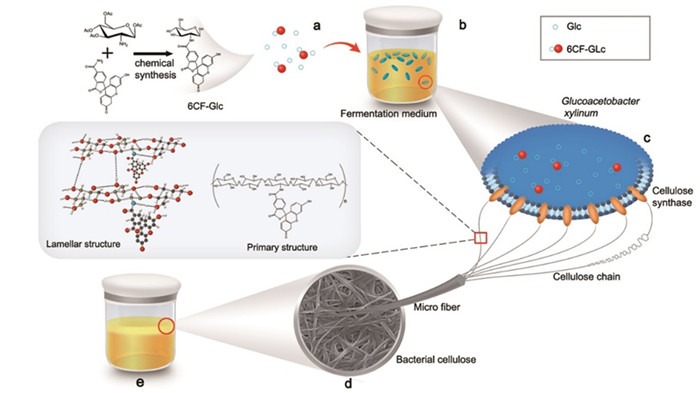Bacterial cellulose (BC) is a cellulose material produced by microbial fermentation with a unique porous network structure. Due to the high crystallinity, high specific surface area, high degree of polymerization, excellent permeability, high porosity and excellent mechanical properties, functionalized BC has excellent application prospects in many fields, such as chemical sensing, biological imaging, ultraviolet shielding, oil adsorption, fuel cells, biomedical materials, ion detection and anti-counterfeiting labels.
At present, BC is often functionalized with physical coating or chemical modification. The physical coating can provide a mild modification condition, but functional moieties potentially suffer from shedding. The chemically modified materials are difficult to implement industrial-scale production, due to their poor performance and serious environmental pollution.
Recently, a research team, led by Prof. XIAN Mo and ZHANG Haibo from Qingdao Institute of Bioenergy and Bioprocess Technology (QIBEBT), Chinese Academy of Sciences (CAS), developed a new method for bacterial cellulose functionalization.
BC with unnatural characteristic fluorescent functionality was obtained through in situ fermentation of Komagataeibacter sucrofermentans (K. sucrofermentans) using 6-carboxyfluorescein-modified glucose (6CF- Glc) as a substrate (Figure 1).
The method verifies the feasibility of in situ synthesis of functional materials by microbial fermentation, achieves the microbial synthesis of fluorescent functional cellulose materials and successfully extends the synthetic biology to the field of material functionalization.
The excellent properties of the functional materials were analyzed by various methods, including fluorescence microscopy, laser scanning confocal microscope, nuclear magnetic resonance spectrometer, Fourier transform infrared spectrometer and scanning electron microscopy, which were also compared with that of cellulose obtained by traditional modification methods.
The method has the advantages of green, low cost, controllable and uniform distribution of functional moieties, which also solves the bottleneck problem in the synthesis and performance of functional materials, and is expected to achieve the chiral modification of functional molecules on specific molecular sites.
This work not only provides new insights and ideas for the biosynthesis of functional BC materials, but also provides a new perspective for the in situ synthesis of other functional materials by microorganisms.
The related findings were published in Nature Communications. The research was supported by the National Natural Science Foundation of China, the Chinese Academy of Sciences Youth Promotion Association, the Hainan Provincial Key Research and Development Program and the Shandong Taishan Climbing Program.

Figure.1 Synthesis of 6CF-BC based on an in situ microbial fermentation method. Glucose (Glc) was modified with 6CF, and the 6CF-Glc was used as a carbon source for K. sucrofermentans fermentation to obtain 6CF-BC through microbial metabolic pathways. (Image by GAO Minghong)
(Text by GAO Minghong)
Contact:
CHENG Jing
Qingdao Institute of Bioenergy and Bioprocess Technology, Chinese Academy of Sciences
Tel: 86-532-80662647
E-mail: chengjing@qibebt.ac.cn